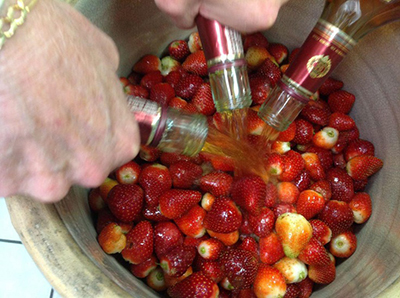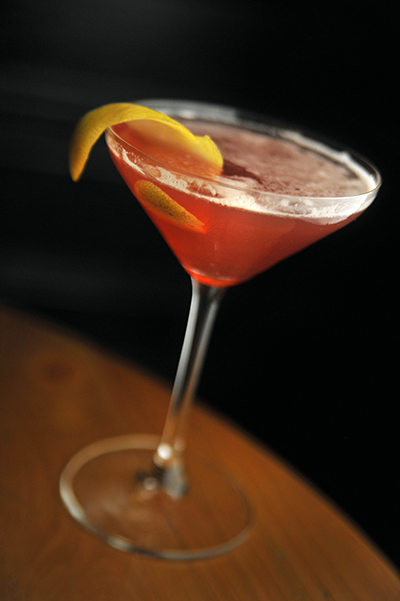 “Ratafia” is defined as an infusion of a base spirit, typically brandy and fruit. The name comes from the Latin base word “Rata Fiat.” Originally, this term came from Catholic wedding ceremonies to announce the marriage as “rafitifed,” breaking down the Latin phrase “rata,” or, official and “fiat,” or, let it be done. Eventually, the term ratafia became synonymous with the idea of a combination of two things. In this case, a wonderful beverage marriage of brandy and fruit.
“Ratafia” is defined as an infusion of a base spirit, typically brandy and fruit. The name comes from the Latin base word “Rata Fiat.” Originally, this term came from Catholic wedding ceremonies to announce the marriage as “rafitifed,” breaking down the Latin phrase “rata,” or, official and “fiat,” or, let it be done. Eventually, the term ratafia became synonymous with the idea of a combination of two things. In this case, a wonderful beverage marriage of brandy and fruit.
Brandy was brought to Louisiana through the Port of New Orleans, and eventually ratafia grew in popularity most notably throughout all of plantation country – everything from the Port of New Orleans to Baton Rouge. During the 30 year re-construction following the Civil War, planation country parishes had the best acces to the “goods.” With supplies limited, plantation owners were driven further into the swamps of Louisiana to make their precious blends.
At Restaurant R’evolution, utilizing what we like to call the “the swamp floor pantry,” we use a variety of fruits as seasonal for making ratafia. These including mayhaw berries, muscadine grapes, and anna apples, local persimmons, blackberries, strawberries, blueberries, and the citrus brought here by the Spanish.
 The traditional basic recipe is as follows: Using a stone croc, add fruit, then fill two inches over with brandy. Cover the croc with cheese cloth and store in a cool and dark place. Let it sit for no less than six months. Once it is ready, strain and add simple syrup for desired sweetness.
The traditional basic recipe is as follows: Using a stone croc, add fruit, then fill two inches over with brandy. Cover the croc with cheese cloth and store in a cool and dark place. Let it sit for no less than six months. Once it is ready, strain and add simple syrup for desired sweetness.
Of course, you can enjoy this liquor in many forms – with or without sugar, as a mixing liqueur or as a strong beverage to sip. The most popular way is adding sugar. We follow the traditional recipe and style, ours on the sweeter side. The plantation owners would use this sweeter liquor as cordials or digestives as well as in cooking. They would reduce it down and use it as a drizzle over desserts, cakes, and cheeses.
Right now, the summertime season is when you pick your fruit and start the wonderful ratafia making process. With it taking six months, it’s ready just in time for the holidays. This is a great tradition, and special bottles are saved for holiday feasts and family events to this day.
“Ratafia is fruits great leap in too immortality the same as cheese is milks great leap in too immortality,” quotes Chef Folse. “And in that way we always remember the past and pay homage to it. Whether it be the fruit from last summer or the traditions from decades past. In the spirit of the Catholic marriage ceremony of ‘Rata Fiat,’ we humbly attempt to marry the present and past. We always use local fruits and use traditional recipes when making our ratafia at R’evolution.”
About Restaurant R’evolution
Restaurant R’evolution opened to the public in June 2012. The elegant 6,000 square-foot fine dining restaurant, which seats 160, is the first joint venture for chefsJohn Folse and Rick Tramonto’s restaurant development company, Home on the Range. Located in the heart of the French Quarter at 777 Bienville Street in the landmark Royal Sonesta Hotel New Orleans, Restaurant R’evolution’s cuisine is a modern and imaginative reinterpretation of classic Cajun and Creole styles. The restaurant is a celebration of the cultural fusion of the food and flavor that has shaped the culinary landscape of New Orleans. For your convenience, valet parking is available at the restaurant’s Bienville Street entrance or inside the Royal Sonesta Hotel’s parking garage. Attire is casual but proper. For reservations, call504.553.2277. For more information, please visit us at www.revolutionnola.com or follow the restaurant on Facebook, Twitter or Restaurant R’evolution’s Blog for a behind-the-scenes peek inside one of New Orleans’ most exciting restaurants.






